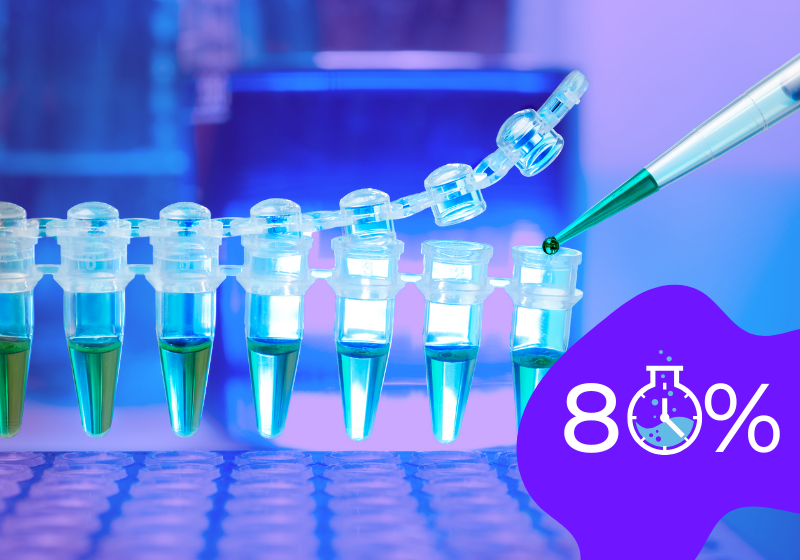In modern laboratories, efficiency is often limited by repetitive, time-consuming tasks. Routine activities, including sample preparation, data collection, and workflow scheduling, can dominate daily operations. These processes lead to project delays, increase the risk of human error, and generate bottlenecks across teams. The outcome is decreased productivity and added pressure on staff tasked with managing heavy workloads under tight deadlines.
Automation provides a strategic solution to these challenges. By streamlining workflows, reducing physical demands, and minimizing variability, automated systems return valuable hours to scientific work. Instead of spending endless time on execution, teams can focus on interpretation, decision-making, and innovation.
This article examines where automation delivers the greatest efficiency gains, presents evidence showing laboratories can reclaim over 80% of their time, and introduces Director™, a lab automation software designed to make automation practical and effective.
The Hidden Cost of Manual Processes
Even highly skilled lab staff are constrained by the limits of manual processes. Common challenges include:
- Hours lost due to repetitive pipetting, plate transfers, and sample management
- Scheduling inefficiencies that leave instruments idle or requiring late-night work
- Physical and cognitive fatigue from extended hands-on activity
- Communication gaps that create bottlenecks when multiple staff share resources
These inefficiencies not only waste time but also increase variability, compromise data quality, and strain limited resources. This accumulates into substantial project delays, diverting attention away from higher-value tasks.
Laboratory Workflows Optimized by Automation
Automated systems deliver the greatest benefits in workflows requiring precision, throughput, and consistency. Key areas include:
- High-throughput screening
Robotic plate handling and liquid transfers eliminate variability, compressing multi-day experiments into shorter time frames. - Cell culture management
Integrated systems handle processes such as incubator access, media exchange, and imaging, reducing hands-on involvement. - Genomic workflows
From library preparation to sequencing, instrument-driven methods maintain reproducibility while reducing turnaround times. - Clinical diagnostics
Advanced scheduling and workflow control ensure compliance while enabling faster, more consistent delivery of results
In each of these areas, automation not only accelerates individual processes but also minimizes the hidden delays caused by manual oversight, instrument setup, and scheduling conflicts.
Case Study: Chemistry Robotic Assistant Saves 80% of Researchers’ Time
Darvish et al. (2024) highlighted the measurable impact of automated systems in chemistry laboratory processes. For this paper, researchers evaluated multi-step chemistry workflows, including sample preparation, characterization, and data capture, which traditionally required extensive manual repetition. The study found that this automated system reduced physical and cognitive strain by more than 50%, lowering fatigue and improving accuracy. The automated system also allowed researchers to save, on average, 80% of their time.
Repetitive processes were completed far more efficiently through synchronized, system-driven workflows. When applied across multiple projects, this efficiency enables teams to run more experiments simultaneously, shorten development timelines, and focus on data-driven insights. This demonstrates that automated systems are a fundamental improvement in laboratory efficiency, rather than just a convenience.
Director™: Smart Automation
Director™ is lab scheduling software that allows lab automation to operate efficiently and effectively, with features designed to deliver measurable time savings:
- Flexible Workflow Management
Build, edit, and simulate methods while systems are in use, reducing downtime. - Real-Time Monitoring and Control
Access and adjust active runs from multiple devices, preventing delays and ensuring continuous operation. - Customizable Interfaces
Streamline training and reduce setup time with user interfaces tailored to specific laboratory processes. - Comprehensive Data Integrity
Manage inventory, track workflows, and maintain compliance with standards such as 21 CFR Part 11, all within a single platform.
By coordinating equipment, staff, and protocols, this software eliminates hidden scheduling inefficiencies, ensuring experiments proceed without interruption.
Conclusion
Time is one of the most valuable resources in any laboratory. Minimizing manual, repetitive tasks directly improves productivity, throughput, and research outcomes. By integrating system-driven workflows and intelligent scheduling, laboratories can reclaim significant hours throughout the workday, enabling teams to run more experiments, accelerate project timelines, and focus on high-value analytical work. Director™ provides a practical, centralized solution to implement these efficiencies, turning time savings into tangible improvements across day-to-day operations.
Tired of losing hours to repetitive tasks? Contact us today to book a demo and discover how Director™ can help your team save time and boost productivity.

